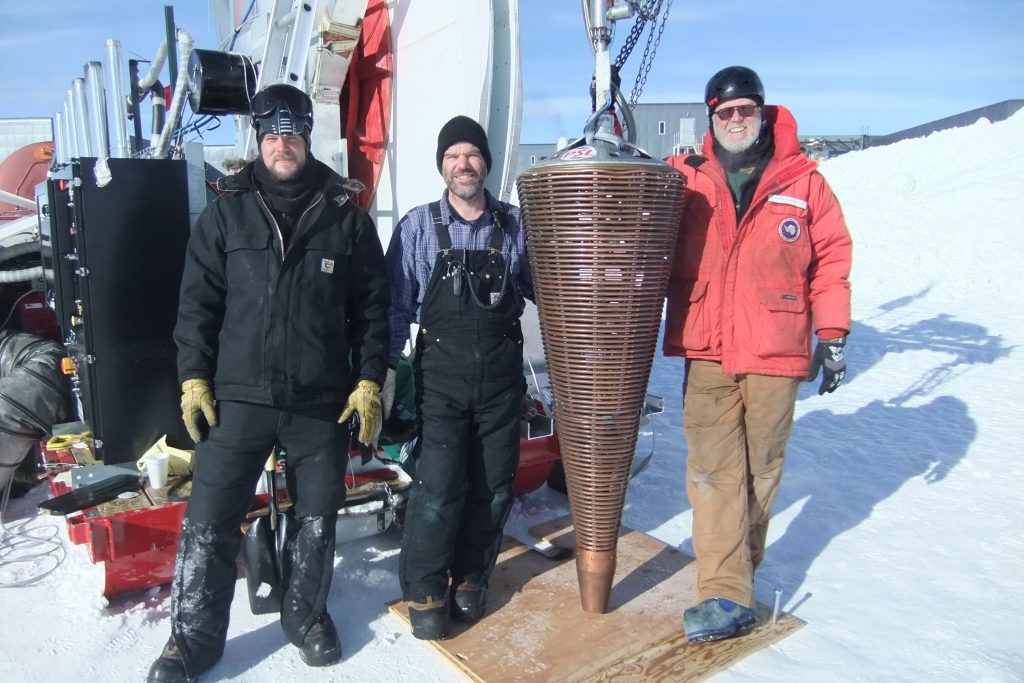Career Badger Engineer Named Director of the Physical Sciences Laboratory
Terry Benson plans to return to Antarctica in November for the 10th time. But this time, instead of being a student, when he shuffles over the ice, he will lead an engineering team as the new director of the UW–Madison Physical Sciences Laboratory, working on the IceCube Neutrino Observatory upgrade project.
IceCube is the first detector of its kind, designed to observe the cosmos from deep within the South Pole ice. The detector searches for nearly massless subatomic particles called neutrinos, which provide information to probe the most violent astrophysical sources: exploding stars, gamma-ray bursts, and cataclysmic phenomena involving black holes and neutron stars.
Benson spent his entire student college career at UW–Madison and graduated in 2008 with a master’s degree in mechanical engineering. As a student, he worked on the initial IceCube international collaboration project and that’s where he met former PSL Director Bob Paulos.

Benson with Jeff Cherwinka and Darrell Hamilton, all PSL staff, at the South Pole with PSL equipment.
Paulos retired in October 2023. Before becoming PSL director, Paulos had been associate director for the IceCube program and led the development of the management, organization and budgetary plans submitted in the original proposal to the National Science Foundation in 1999.
“As a student, I stumbled upon on the PSL website and thought, ‘That would be an exciting place to work’,” Benson recalls.
In 2010 he got his wish, joining the PSL staff as an instrumentation engineer. When Paulos retired, Benson was named PSL’s interim director.
“Bob was a great mentor,” says Benson who became permanent PSL director on Aug. 13. “We’ve known each other for 20 years since first working together on IceCube.”
Benson says, as PSL director, he has a new appreciation for the administrative work by staff such as Elizabeth Danielak, administrative associate director of PSL, that goes into keeping a research lab such as PSL up and running.
PSL, located in Stoughton, has about 40 staff including physicists, engineers, highly skilled technicians such as welders and machinists, and several students onsite, who create unique, often highly sophisticated research tools.
As director, Benson reports to the Vice Chancellor for Research and Graduate Education. PSL has served campus and external and private partners since 1967 and provides a range of services including consulting, design, fabrication and calibration services in scientific instrumentation. The Stoughton site features a state-of-the-art machinery and electronics shop. Many of the services that the PSL provides are customized for each given project or unique situation.
“Terry is a world-class mechanical engineer and is respected by his colleagues on and off campus for his creative and collaborative nature,” says Amy Wendt, vice chancellor for research in the physical sciences. “We are excited by his enthusiasm for PSL and respect for its staff, and the inventive mindset he brings to his new leadership position at PSL.”
Benson says the best advice Paulos gave him when leaving PSL in Benson’s hands, was to trust “the people,” referring to the PSL staff.
“The PSL staff is a great group that is creative and supportive – like a family,” Benson says. “They are very good at their jobs and tackle some truly challenging and first-of their-kind projects.”
In addition to IceCube, PSL has participated in the construction of particle physics detectors at CERN, Fermilab and elsewhere. The center was an integral part of the design and construction of the Compact Muon Solenoid (CMS) detector, one of the detectors in the Large Hadron Collider, which lead to discovery of an elementary particle called the Higgs boson.s supporting an international collaboration called the Deep Underground Neutrino Experiment (DUNE) and continues to play a key role in DUNE detector development and production. And recently, PSL made significant contributions to the LUX- ZEPLIN (LZ) experiment, an underground dark matter detector at the Sanford Underground Research Facility (SURF) in Lead, South Dakota. PSL’s Jeff Cherwinka served as LZ’s chief engineer. Benson and others from PSL also provided support for the project.
But Benson’s goals for PSL include establishing and building collaborations with researchers across campus, not only as a service for large grant projects like IceCube and DUNE, but also for intricate, interesting and impactful smaller budget research projects. In fact, more than 6,000 projects, big and small, have been executed over the lab’s history.
PSL supports The Wisconsin HTS Axisymmetric Mirror (WHAM), an experimental device that will be a prototype for future next-generation fusion power plants, as a host facility. Construction of the WHAM experiment at PSL is funded by a grant through the Physics Department from ARPA-E, a branch of the U.S. Department of Energy that supports the development and commercialization of advanced energy concepts.
Benson also has been part of an OVCRGE-funded Research Forward project,
Benson also has been part of an OVCRGE-funded Research Forward project, “Integrated stellarator concept study for a new U.S. stellarator experiment at UW– Madison,” to support the UW fusion plasma science and technology community to mature their vision of a new mid-scale stellarator research facility, developed at the College of Engineering and the College of Letters and Sciences.
A favorite project for Benson has been the Center for Limnology’s Fast Limnology Automated Measurement (FLAMe) platform that can be used to generate detailed, spatially-explicit, real-time observations of surface water quality. FLAMe was supported by an OVCRGE UW2020 grant. As a mechanical engineer at PSL, Benson supported the project by making improvements to the boat mounted water testing rig.
“FLAMe, for example, was a smaller project for PSL, but there were still some tricky technical challenges, and our work ended up having a big impact for researchers on the project,” Benson says. “That makes the project just as fulfilling for PSL as some of the bigger projects.”
By Natasha Kassulke, natasha.kassulke@wisc.edu

